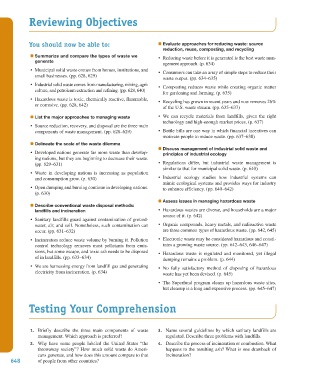Page 649 - Environment: The Science Behind the Stories
P. 649
Reviewing Objectives
You should now be able to: Evaluate approaches for reducing waste: source
reduction, reuse, composting, and recycling
Summarize and compare the types of waste we • Reducing waste before it is generated is the best waste man-
generate
agement approach. (p. 634)
• Municipal solid waste comes from homes, institutions, and • Consumers can take an array of simple steps to reduce their
small businesses. (pp. 628, 629)
waste output. (pp. 634–635)
• Industrial solid waste comes from manufacturing, mining, agri- • Composting reduces waste while creating organic matter
culture, and petroleum extraction and refining. (pp. 628, 640)
for gardening and farming. (p. 635)
• Hazardous waste is toxic, chemically reactive, flammable, • Recycling has grown in recent years and now removes 26%
or corrosive. (pp. 628, 642)
of the U.S. waste stream. (pp. 635–637)
List the major approaches to managing waste • We can recycle materials from landfills, given the right
technology and high-enough market prices. (p. 637)
• Source reduction, recovery, and disposal are the three main
components of waste management. (pp. 628–629) • Bottle bills are one way in which financial incentives can
motivate people to reduce waste. (pp. 637–638)
Delineate the scale of the waste dilemma
Discuss management of industrial solid waste and
• Developed nations generate far more waste than develop- principles of industrial ecology
ing nations, but they are beginning to decrease their waste.
(pp. 629–631) • Regulations differ, but industrial waste management is
similar to that for municipal solid waste. (p. 640)
• Waste in developing nations is increasing as population
and consumption grow. (p. 630) • Industrial ecology studies how industrial systems can
mimic ecological systems and provides ways for industry
• Open dumping and burning continue in developing nations. to enhance efficiency. (pp. 640–642)
(p. 630)
Assess issues in managing hazardous waste
Describe conventional waste disposal methods:
landfills and incineration • Hazardous wastes are diverse, and households are a major
source of it. (p. 642)
• Sanitary landfills guard against contamination of ground-
water, air, and soil. Nonetheless, such contamination can • Organic compounds, heavy metals, and radioactive waste
occur. (pp. 631–632) are three common types of hazardous waste. (pp. 642, 645)
• Incinerators reduce waste volume by burning it. Pollution • Electronic waste may be considered hazardous and consti-
control technology removes most pollutants from emis- tutes a growing waste source. (pp. 642–643, 646–647)
sions, but some escape, and toxic ash needs to be disposed • Hazardous waste is regulated and monitored, yet illegal
of in landfills. (pp. 633–634) dumping remains a problem. (p. 644)
• We are harnessing energy from landfill gas and generating • No fully satisfactory method of disposing of hazardous
electricity from incineration. (p. 634) waste has yet been devised. (p. 645)
• The Superfund program cleans up hazardous waste sites,
but cleanup is a long and expensive process. (pp. 645–647)
Testing Your Comprehension
1. Briefly describe the three main components of waste 3. Name several guidelines by which sanitary landfills are
management. Which approach is preferred? regulated. Describe three problems with landfills.
2. Why have some people labeled the United States “the 4. Describe the process of incineration or combustion. What
throwaway society”? How much solid waste do Ameri- happens to the resulting ash? What is one drawback of
cans generate, and how does this amount compare to that incineration?
648 of people from other countries?
M22_WITH7428_05_SE_C22.indd 648 18/12/14 10:57 AM

